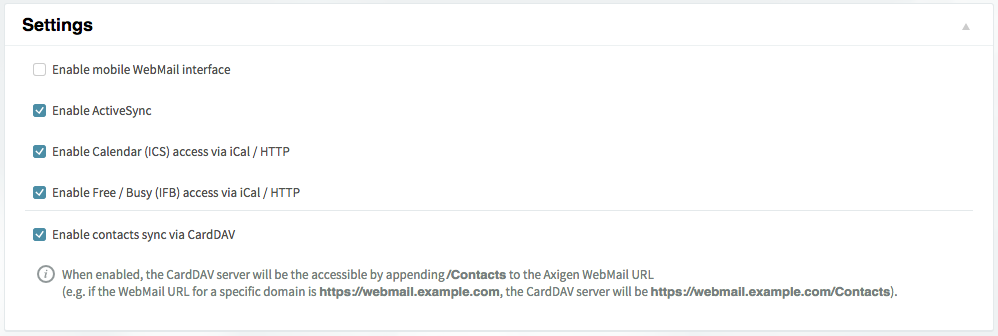The CardDAV compatibility and support built into Axigen aims to provide contact synchronization between the Axigen service and an external CardDAV client accessing the information across the network.
CardDAV updates in Axigen X3:
-
Multiple Contact folders
-
Starting with version X3, instead of synchronizing the Contacts folder, Axigen synchronizes two virtual collections: a collection that contains all the editable contacts (the contacts the current user is allowed to edit) and a directory collection that contains all the contacts from the Public Contacts and Domain Contacts public folders.
-
-
The virtual contacts collection
-
The friendly name of this collection (as displayed in CardDAV clients) is "Axigen Contacts".
-
-
The directory gateway collection
-
Starting with version X3, Axigen adds support for a CardDAV directory gateway.
-
The directory gateway is a virtual collection (search folder) powered by the Domain Contacts and Public Contacts public folders.
-
The friendly name of this collection (as displayed in CardDAV clients) is "Axigen Directory".
-
The directory is meant to be used (i.e. by applications that understand Apple's CardDAV directory gateway extension) by searching based on a given pattern.
-
The typical use case is the directory becomes a contact provider so when a new message is composed the MUA (e.g. Mail.app) queries the directory (using a REPORT addressbook-query) whenever the user provides a partial input on a recipient field. The server searches the directory for the given pattern and returns a set of matching contacts. Axigen performs diacritical folding on both the search pattern and the contact fields before checking for a match.
-
Known issues:
-
Although Calendar.app includes the nickname in the query filter, Axigen does not support querying for the nickname field as the nickname field is not a part of the server contact index.
Minimum Requirements
This section lists the software requirements that the systems and software products used for iCalendar integration and syncs should meet. The hardware requirements are not listed in this section as they can vary to great extent from one environment to another. For details on the hardware required in specific scenarios, you should contact the Sales Team.
Mandatory software packages:
-
An operating system compatible with Axigen version 9.0 or newer
-
Axigen version 9.0 or newer
-
The CardDAV service must be enabled in Axigen
-
A CardDAV client application
Supported CardDAV clients (Axigen X2 Update 2):
-
iOS 12
-
Android 8+ (running the CardDAV Sync free application installed from Google's Play Store)
-
macOS Mojave
-
Thunderbird (using the SOGO Connector)
Feature Design
The CardDAV service is built on top of the WebDAV service.
The CardDAV service is proxy-able in a cluster environment without any special configuration (i.e. once the WebMail works via the proxy, the CardDAV service works too).
Naming scheme change in Axigen X1
Starting with Axigen version X1 CardDAV clients that are capable of auto-discovery should find the CalDAV services using Axigen's WebMail address, e.g. https://webmail.axigen.url.
For CardDAV clients that are unable to perform auto discovery, the Contacts collection URL is https://webmail.axigen.url/Contacts/Contacts.
Axigen Configuration
To enable CardDAV support in the Axigen product, the administrator must log in and enable the respective option in the CLI or in the Webmail service configuration context. In the default configuration, CardDAV support is enabled.
WebAdmin Vonfiguration
WebAdmin configuration for CardDAV resides in the "Services → Mobility & Sync" context.
CLI Configuration
CardDAV Groups
Axigen's groups as defined in WebMail and Outlook Connector are created using our proprietary VCARD properties and are not visible in iOS and macOS.
iOS and macOS use their own properties when modelling groups and these are not yet understood by Axigen.
This means that Axigen will synchronize a Contacts group but WebMail will not be able to display the group definition.
